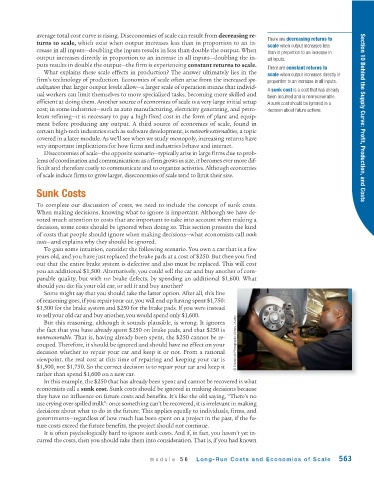Page 605 - Krugmans Economics for AP Text Book_Neat
P. 605
average total cost curve is rising. Diseconomies of scale can result from decreasing re-
There are decreasing returns to
turns to scale, which exist when output increases less than in proportion to an in-
scale when output increases less
crease in all inputs—doubling the inputs results in less than double the output. When than in proportion to an increase in
output increases directly in proportion to an increase in all inputs—doubling the in- all inputs.
puts results in double the output—the firm is experiencing constant returns to scale.
There are constant returns to
What explains these scale effects in production? The answer ultimately lies in the scale when output increases directly in
firm’s technology of production. Economies of scale often arise from the increased spe- proportion to an increase in all inputs.
cialization that larger output levels allow—a larger scale of operation means that individ-
A sunk cost is a cost that has already
ual workers can limit themselves to more specialized tasks, becoming more skilled and been incurred and is nonrecoverable.
efficient at doing them. Another source of economies of scale is a very large initial setup A sunk cost should be ignored in a
cost; in some industries—such as auto manufacturing, electricity generating, and petro- decision about future actions.
leum refining—it is necessary to pay a high fixed cost in the form of plant and equip- Section 10 Behind the Supply Curve: Profit, Production, and Costs
ment before producing any output. A third source of economies of scale, found in
certain hi gh- tech industries such as software development, is network externalities, a topic
covered in a later module. As we’ll see when we study monopoly, increasing returns have
very important implications for how firms and industries behave and interact.
Diseconomies of scale—the opposite scenario—typically arise in large firms due to prob-
lems of coordination and communication: as a firm grows in size, it becomes ever more dif-
ficult and therefore costly to communicate and to organize activities. Although economies
of scale induce firms to grow larger, diseconomies of scale tend to limit their size.
Sunk Costs
To complete our discussion of costs, we need to include the concept of sunk costs.
When making decisions, knowing what to ignore is important. Although we have de-
voted much attention to costs that are important to take into account when making a
decision, some costs should be ignored when doing so. This section presents the kind
of costs that people should ignore when making decisions—what economists call sunk
costs—and explains why they should be ignored.
To gain some intuition, consider the following scenario. You own a car that is a few
years old, and you have just replaced the brake pads at a cost of $250. But then you find
out that the entire brake system is defective and also must be replaced. This will cost
you an additional $1,500. Alternatively, you could sell the car and buy another of com-
parable quality, but with no brake defects, by spending an additional $1,600. What
should you do: fix your old car, or sell it and buy another?
Some might say that you should take the latter option. After all, this line
of reasoning goes, if you repair your car, you will end up having spent $1,750:
$1,500 for the brake system and $250 for the brake pads. If you were instead
to sell your old car and buy another, you would spend only $1,600.
But this reasoning, although it sounds plausible, is wrong. It ignores
the fact that you have already spent $250 on brake pads, and that $250 is
nonrecoverable. That is, having already been spent, the $250 cannot be re-
couped. Therefore, it should be ignored and should have no effect on your © Greatstock Photographic Library / Alamy
decision whether to repair your car and keep it or not. From a rational
viewpoint, the real cost at this time of repairing and keeping your car is
$1,500, not $1,750. So the correct decision is to repair your car and keep it
rather than spend $1,600 on a new car.
In this example, the $250 that has already been spent and cannot be recovered is what
economists call a sunk cost. Sunk costs should be ignored in making decisions because
they have no influence on future costs and benefits. It’s like the old saying, “There’s no
use crying over spilled milk”: once something can’t be recovered, it is irrelevant in making
decisions about what to do in the future. This applies equally to individuals, firms, and
governments—regardless of how much has been spent on a project in the past, if the fu-
ture costs exceed the future benefits, the project should not continue.
It is often psychologically hard to ignore sunk costs. And if, in fact, you haven’t yet in-
curred the costs, then you should take them into consideration. That is, if you had known
module 56 Long-Run Costs and Economies of Scale 563

